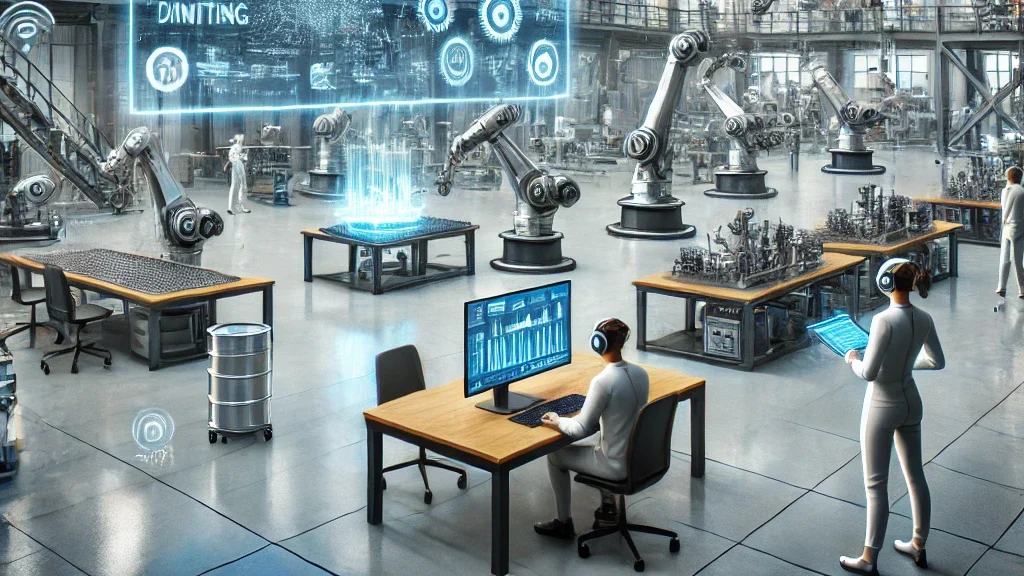The field of industrial informatics, which integrates information technology with industrial automation, continues to evolve rapidly. In 2024, several groundbreaking innovations have redefined how industries approach efficiency, sustainability, and digital transformation. Below, we explore the key trends and technologies shaping this dynamic sector.

1. Edge Computing and IIoT Advancements
Edge computing has been a growing trend for years, but in 2024, it has reached new levels of sophistication. Industrial Internet of Things (IIoT) devices, now equipped with advanced edge computing capabilities, allow for real-time processing of data directly at the source. This minimizes latency and reduces the need for extensive cloud infrastructure.
Notable Developments:
- AI-Powered Edge Devices: Manufacturers are leveraging AI to improve predictive maintenance and quality control. These devices can analyze vast amounts of sensor data in real time, identifying anomalies and preventing downtime.
- Interoperability Standards: Organizations like the Industrial Internet Consortium (IIC) have introduced enhanced interoperability frameworks, enabling seamless communication between heterogeneous devices.
2. AI-Driven Manufacturing
Artificial intelligence (AI) has transformed industrial informatics by introducing smarter and more autonomous systems. In 2024, the integration of generative AI into industrial operations has enabled adaptive systems that can learn and improve over time.
Key Applications:
- Generative Design: AI algorithms now assist in the design of complex machinery and components, optimizing material use and performance.
- Cognitive Robots: Collaborative robots (cobots) are becoming more intuitive, thanks to AI, enhancing their ability to work alongside humans in dynamic environments.
3. Digital Twins 2.0
Digital twin technology has been a staple in industrial informatics for simulating and optimizing processes. In 2024, the technology has evolved into what experts are calling Digital Twins 2.0, offering hyper-realistic simulations with enriched functionality.
Enhanced Features:
- Real-Time Bi-Directional Updates: Modern digital twins can instantly reflect changes from the physical world, enabling better decision-making.
- Multi-Twin Systems: Industries are now creating networks of digital twins to simulate entire ecosystems, from supply chains to factory floors.
4. Cybersecurity Innovations
With the rise of connected systems, cybersecurity has become paramount. In 2024, industries are adopting zero-trust architectures and advanced threat detection systems to safeguard critical infrastructure.
Advances in Security:
- AI-Driven Threat Detection: Machine learning models now analyze network traffic for anomalies, enabling proactive defenses.
- Quantum Cryptography: Emerging quantum-safe encryption protocols are being tested in industrial settings to counteract potential threats from quantum computing.
5. Sustainable Informatics
Sustainability is no longer optional; it’s a core principle driving industrial innovation. Informatics technologies are playing a critical role in achieving environmental goals.
Key Strategies:
- Energy-Efficient Computing: New low-power processors and optimized algorithms are reducing energy consumption in industrial applications.
- Circular Economy Solutions: Informatics platforms are enabling better resource tracking and reuse, supporting circular economy initiatives.
6. 5G and Private Networks
The deployment of 5G networks and private industrial networks has unlocked unprecedented levels of connectivity. These advancements are enabling more reliable and faster communication in industrial environments.
Transformative Impact:
- Low-Latency Communication: Real-time control of machinery and robotics is now more feasible, boosting operational efficiency.
- Enhanced Remote Operations: 5G’s capabilities support augmented reality (AR) and virtual reality (VR) applications, enhancing remote monitoring and training.
7. Advanced MES and ERP Systems
Manufacturing Execution Systems (MES) and Enterprise Resource Planning (ERP) platforms have seen significant upgrades in 2024. These systems are now more integrated, intelligent, and user-friendly.
Noteworthy Features:
- AI-Enhanced Decision Support: Real-time data analytics provide actionable insights for managers, optimizing production schedules and inventory management.
- Seamless Cloud Integration: Hybrid solutions are bridging the gap between on-premises and cloud systems, offering greater flexibility.
8. Blockchain in Supply Chain Management
Blockchain technology is making inroads into industrial informatics, particularly in supply chain management. In 2024, its adoption has expanded to ensure transparency, traceability, and trust.
Use Cases:
- Product Provenance: Companies can now track raw materials from origin to finished goods, ensuring compliance and ethical sourcing.
- Smart Contracts: Automated contracts reduce administrative overhead and enhance transactional reliability.
9. Augmented and Virtual Reality
AR and VR technologies are becoming indispensable tools in industrial informatics. From design to maintenance, these immersive technologies are revolutionizing workflows.
Applications in 2024:
- Training Simulations: Workers can be trained in virtual environments that replicate real-world conditions.
- AR Maintenance Tools: Technicians now use AR headsets to access real-time data overlays and step-by-step instructions, reducing errors and downtime.
10. Quantum Computing Potential
Although still in its early stages, quantum computing is beginning to show its potential in solving complex industrial problems. In 2024, pilot projects are demonstrating its capabilities in optimization and simulation.
Potential Impact:
- Supply Chain Optimization: Quantum algorithms are enabling more efficient logistics and inventory management.
- Material Science: Faster simulations are accelerating the discovery of advanced materials for industrial use.
11. Ethical AI and Governance
With the growing influence of AI in industrial informatics, ethical considerations have become a priority. In 2024, frameworks and guidelines are emerging to ensure responsible AI deployment.
Initiatives:
- Transparent AI Models: Industries are demanding explainable AI to build trust and comply with regulations.
- Bias Mitigation: New tools are addressing biases in algorithms to ensure fairness and inclusivity.
Conclusion
The innovations in industrial informatics in 2024 are not just enhancing productivity and efficiency but are also shaping a more sustainable and secure future. As industries continue to adopt these technologies, they must balance technological advancement with ethical considerations and environmental responsibility. The year 2024 marks a pivotal chapter in the ongoing evolution of industrial informatics, setting the stage for even greater achievements in the years to come.
SourcesIndustrial Informatics, Innovations 2024, Edge Computing, Industrial IoT, AI in Manufacturing, Digital Twins, Cybersecurity, Sustainable Technology, 5G Connectivity, Blockchain in Industry, Augmented Reality, Quantum Computing, Ethical AI, Smart Manufacturing, Industry 4.0
Sources and Further Reading
https://www.industrynet.com/blog/top-manufacturing-innovations-in-2024?utm_source=chatgpt.com
https://www.automateshow.com/blog/see-these-5-2024-trends-at-automate?utm_source=chatgpt.com
